Endurance Events and Lactate Testing
With Emphasis on the Triathlon
2 of 19
What does it mean to be faster in a race?
An insight into athletic performance
What does the term faster mean? This is not a silly question, and the answer to it is the secret to an optimal physiological performance in a race. It usually means who can get to the finish line sooner. That depends on whether the finish line is 200 m away, 1,500 m away, 10,000 m away, 26.2 miles away for a runner or 140.6 miles for an Ironman length race. The fastest over 200 m will almost certainly not be the fastest over 1,500 m and may not even be able to finish a race of 10,000 m, let alone a marathon. And many triathletes may not be able to finish an Ironman. The following discussion will illustrate what is obvious to everyone but which is rarely considered when preparing for a competition.
The primary physiological objective of training is to maximize the rate of energy release for the event that the athlete is preparing. We emphasize rate because it is the ability to sustain a high rate of energy production per unit of time over the entire event that is important, not the maximum capacity for producing a short burst of energy or the ability to seemingly go on forever.
Let’s look at two very different runners, a sprinter and a marathoner. First, have them race each other at 200 m. The sprinter will beat the marathoner over 200 m fairly easily because the sprinter is able to sustain a higher rate of energy production for 200 m. The typical person would say the sprinter is faster.
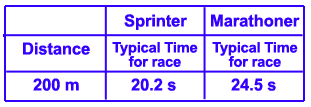
comparison of two different types of runners for a 200 m race
For a longer race the situation is reversed. The marathoner will beat the sprinter over 10,000 m because the marathoner is able to sustain a higher rate of energy production for 10,000 m. The time we estimated for the sprinter over this long distance is optimistic since it is unlikely he will be able to even finish the race.
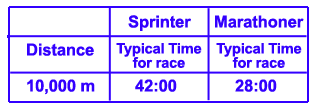
comparison of two different types of runners for a 10 k race
The typical person would say the marathoner is not necessarily faster but has better endurance. In fact the marathoner is faster over the 10,000 m course. But why? Why can't the sprinter keep up the high rate of speed he exhibited in the 200 m race? We all intuitively know what happens because we have all sprinted and then had to slow down. But what does this difference mean for training?
What is it about the metabolism of the marathoner that enables the higher rate of sustained energy production for a 10 k race? A typical response has been that the marathoner has a higher VO2 max. But is this true? And if true, is this the answer? Notice even the marathoner has to slow down considerably when running 10,000 m.
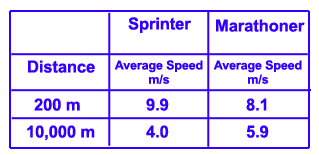
comparison of two different types of runners for a 200 m and 10 k race
In each situation the winner was able to sustain a higher rate of energy production per unit of time for the length of the race. In each race both runners were using their aerobic and anaerobic systems.
Most would say that the reason marathoners do better in the 10,000 m is because they have better aerobic systems than the sprinters. This may or may not be true. World-class sprinters often have aerobic systems that are as strong as top marathoners. Runners in the 400 m Olympic finals almost assuredly have extremely high aerobic capacities. So why do marathoners do so much better in longer races? The main reason marathoners can run faster over 10,000 m is not that they have stronger aerobic systems but weaker anaerobic systems. This last sentence may be one of the most important factors for successful training yet few have ever heard this before. Have you?
To say that someone is faster because they are weaker seems to be a contradiction. We have been conditioned to think that if athletes are faster, then they are stronger. But this apparent paradox is key for successful training of most athletes, for whatever distance. It will be discussed in detail in a later section in this focus on triathlon training. We will show that the anaerobic system is the gateway to the use of the aerobic system. For shorter events such as competitive swimming, the aerobic system returns the favor and becomes the gateway for the use of the anaerobic system.
Now consider three elite runners, a sprinter, a middle-distance runner and a long-distance runner. We ask each to run their best in three different races, 200 m, 1500 m, and 10,000 m. We then see who is fastest by measuring the pace for each race (meters per second). We also measure the VO2 max for each runner and find that the middle-distance and distance runner have almost identical aerobic capacities. The sprinter is surprisingly fairly high too.
The following chart illustrates how each athlete does at each distance. Two things pop up and each is obvious. (1.) Each athlete wins easily at his preferred distance. (2.) The speed for each event goes down as the distance for the event increases, for all runners.
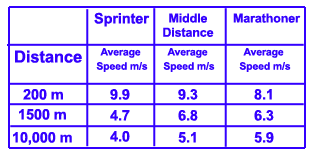
comparison of three different types of runners for three different races
But why should this happen if VO2 max is the same, at least for the middle- and long-distance runners? Why can’t the middle-distance runner do as well as the marathoner in the 10 k race and why is the marathoner not as fast as the middle-distance runner in the 1500 m race? Why does the middle-distance runner beat the marathoner so easily at 200m? It cannot be VO2 max because the athletes are the same on this criterion. The answer to this is what is behind performance at any distance. Namely, it is the interaction of the aerobic and anaerobic systems. It is anaerobic capacity that is driving the speed at which the athlete can complete any race if the VO2 max is the same. But the anaerobic system plays a very different role in short races than it does in long races.
This unconventional explanation for the marathoner’s success at longer distances and the middle distance runner’s success at shorter distances is at the heart of these discussions. This website and this section on the triathlon in particular will hopefully change your understanding of the physiology behind a peak performance, show why the rate of energy production is key to achieving a peak performance, and help you see why the rate that lactate is produced and consumed is at the heart of maximizing the rate of energy production during a race. Once this link is made then the usefulness of lactate testing becomes obvious.
One last question about these athletes is, do they have similar lactate responses to running? The answer is no. The middle distance runner and the marathoner will be similar but be very different from the sprinter. The chart below shows what happens to lactate in the blood as each type of athlete runs faster and faster. But notice that at every speed the sprinter generates more lactate in the blood and at higher speeds the middle distance runner will generate more lactate than the marathoner.
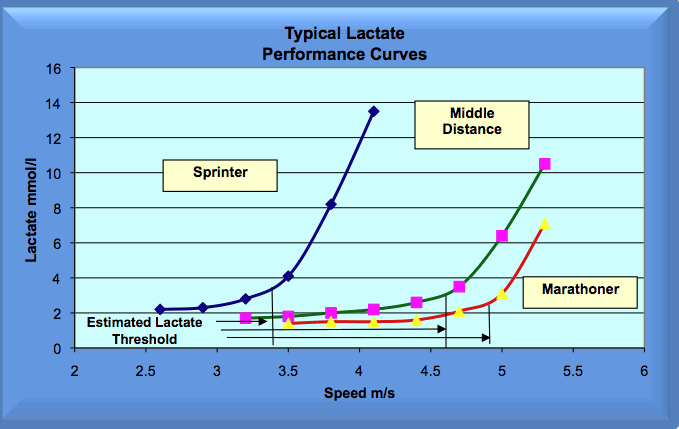
lactate curves for sprinter, middle distance and marathoner
Which athlete will make the best triathlete?
Now an obvious question: which of the three athletes will make a better triathlete? Most will say the sprinter could learn to do one, but it will take a while and he probably will not excel except in some very short events.
Both the middle-distance runner and the marathoner have high VO2 max, so they seem like good candidates. But the marathoner can probably do much better initially at endurance events since he already is good at distance running. He must learn to swim and cycle properly and then develop those muscles.
The middle-distance runner will probably have to lower his anaerobic capacity in order to raise his threshold. But in the end he might be as good as the marathoner or even better. If he is interested in becoming a triathlete or distance runner, he will have to drive down his anaerobic capacity. So his training will emphasize that while he also trains his aerobic system. The anaerobic system is hard to measure, but it can hold you back.
One other important consideration is that an athlete's VO2 max for one sport may not transfer to another. VO2 max has many components. Some are central such as lung and heart functions, which will be similar regardless of the sport. But the other is peripheral, and includes such things as mitochondrial and capillary density and enzyme concentration in specific muscles. Swimming and cycling use different muscles
-------------------------
Continue on to module 3 which discusses why lactate is unique not only in the energy process but as an indicator of the level of performance an athlete is capable of
